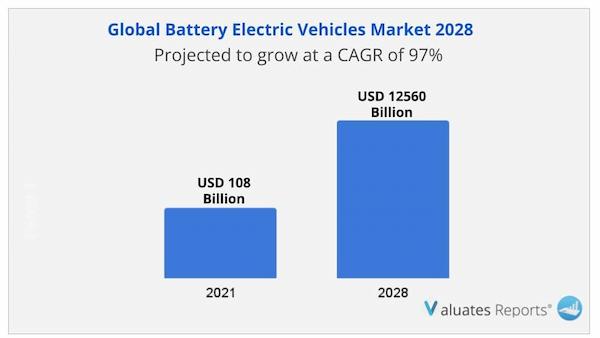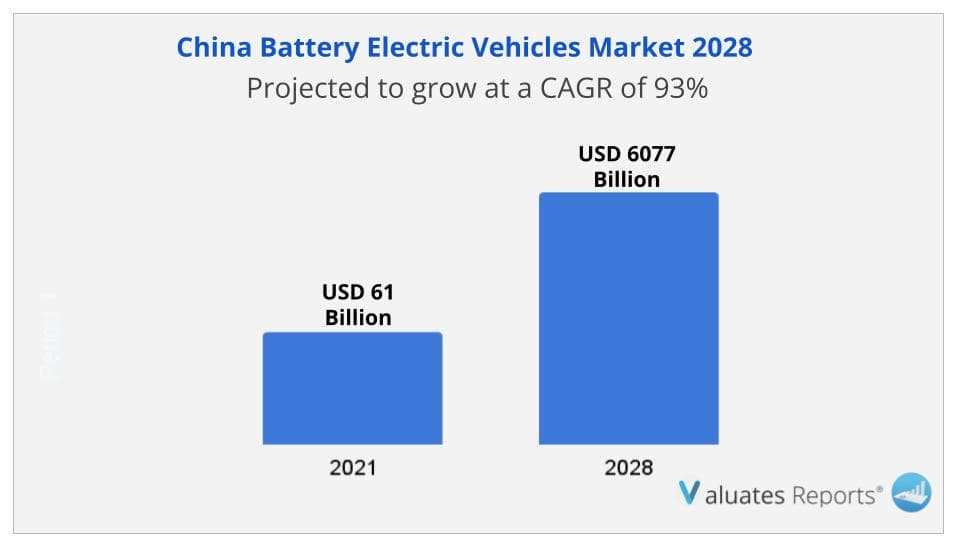List of Tables
Table 1. Global Battery Electric Vehicles Market Size by Type (GWh) & (US$ Million) (2022 VS 2028)
Table 2. Global Battery Electric Vehicles Market Size by Application (GWh) & (US$ Million) (2022 VS 2028)
Table 3. Battery Electric Vehicles Market Size Comparison by Region: 2017 VS 2021 VS 2028
Table 4. Global Battery Electric Vehicles Production by Manufacturers (2017-2022) & (GWh)
Table 5. Global Battery Electric Vehicles Production (GWh) by Manufacturers (2017-2022)
Table 6. Global Battery Electric Vehicles Production Market Share by Manufacturers (2017-2022)
Table 7. Global Battery Electric Vehicles Revenue by Manufacturers (2017-2022) & (US$ Million)
Table 8. Global Battery Electric Vehicles Revenue Share by Manufacturers (2017-2022)
Table 9. Company Type (Tier 1, Tier 2 and Tier 3) & (based on the Revenue in Battery Electric Vehicles as of 2021)
Table 10. Global Market Battery Electric Vehicles Average Price (USD/KWh) of Key Manufacturers (2017-2022)
Table 11. Manufacturers Battery Electric Vehicles Production Sites and Area Served
Table 12. Manufacturers Battery Electric Vehicles Product Types
Table 13. Global Battery Electric Vehicles Manufacturers Market Concentration Ratio (CR5 and HHI)
Table 14. Mergers & Acquisitions, Expansion
Table 15. Global Battery Electric Vehicles Production (GWh) by Region (2017-2022)
Table 16. Global Battery Electric Vehicles Revenue (US$ Million) by Region (2017-2022)
Table 17. Global Battery Electric Vehicles Revenue Market Share by Region (2017-2022)
Table 18. Global Battery Electric Vehicles Production (GWh), Revenue (US$ Million), Price (USD/KWh) and Gross Margin (2017-2022)
Table 19. North America Battery Electric Vehicles Production (GWh), Revenue (US$ Million), Price (USD/KWh) and Gross Margin (2017-2022)
Table 20. Europe Battery Electric Vehicles Production (GWh), Revenue (US$ Million), Price (USD/KWh) and Gross Margin (2017-2022)
Table 21. China Battery Electric Vehicles Production (GWh), Revenue (US$ Million), Price (USD/KWh) and Gross Margin (2017-2022)
Table 22. Japan Battery Electric Vehicles Production (GWh), Revenue (US$ Million), Price (USD/KWh) and Gross Margin (2017-2022)
Table 23. South Korea Battery Electric Vehicles Production (GWh), Revenue (US$ Million), Price (USD/KWh) and Gross Margin (2017-2022)
Table 24. India Battery Electric Vehicles Production (GWh), Revenue (US$ Million), Price (USD/KWh) and Gross Margin (2017-2022)
Table 25. Global Battery Electric Vehicles Consumption Market by Region (2017-2022) & (GWh)
Table 26. Global Battery Electric Vehicles Consumption Market Share by Region (2017-2022)
Table 27. North America Battery Electric Vehicles Consumption by Country (2017-2022) & (GWh)
Table 28. Europe Battery Electric Vehicles Consumption by Country (2017-2022) & (GWh)
Table 29. Asia Pacific Battery Electric Vehicles Consumption by Region (2017-2022) & (GWh)
Table 30. Latin America Battery Electric Vehicles Consumption by Country (2017-2022) & (GWh)
Table 31. Global Battery Electric Vehicles Production (GWh) by Type (2017-2022)
Table 32. Global Battery Electric Vehicles Production Market Share by Type (2017-2022)
Table 33. Global Battery Electric Vehicles Revenue (US$ Million) by Type (2017-2022)
Table 34. Global Battery Electric Vehicles Revenue Share by Type (2017-2022)
Table 35. Global Battery Electric Vehicles Price (USD/KWh) by Type (2017-2022)
Table 36. Global Battery Electric Vehicles Production by Application (2017-2022) & (GWh)
Table 37. Global Battery Electric Vehicles Production Market Share by Application (2017-2022)
Table 38. Global Battery Electric Vehicles Revenue (US$ Million) by Application (2017-2022)
Table 39. Global Battery Electric Vehicles Revenue Share by Application (2017-2022)
Table 40. Global Battery Electric Vehicles Price (USD/KWh) by Application (2017-2022)
Table 41. BMW Battery Electric Vehicles Corporation Information
Table 42. BMW Specification and Application
Table 43. BMW Battery Electric Vehicles Production (GWh), Revenue (US$ Million), Price (USD/KWh) and Gross Margin (2017-2022)
Table 44. BMW Main Business and Markets Served
Table 45. BMW Recent Developments/Updates
Table 46. Daimler Battery Electric Vehicles Corporation Information
Table 47. Daimler Specification and Application
Table 48. Daimler Battery Electric Vehicles Production (GWh), Revenue (US$ Million), Price (USD/KWh) and Gross Margin (2017-2022)
Table 49. Daimler Main Business and Markets Served
Table 50. Daimler Recent Developments/Updates
Table 51. General Motors Battery Electric Vehicles Corporation Information
Table 52. General Motors Specification and Application
Table 53. General Motors Battery Electric Vehicles Production (GWh), Revenue (US$ Million), Price (USD/KWh) and Gross Margin (2017-2022)
Table 54. General Motors Main Business and Markets Served
Table 55. General Motors Recent Developments/Updates
Table 56. Mitsubishi Motors Battery Electric Vehicles Corporation Information
Table 57. Mitsubishi Motors Specification and Application
Table 58. Mitsubishi Motors Battery Electric Vehicles Production (GWh), Revenue (US$ Million), Price (USD/KWh) and Gross Margin (2017-2022)
Table 59. Mitsubishi Motors Main Business and Markets Served
Table 60. Mitsubishi Motors Recent Developments/Updates
Table 61. Nissan Motor Battery Electric Vehicles Corporation Information
Table 62. Nissan Motor Specification and Application
Table 63. Nissan Motor Battery Electric Vehicles Production (GWh), Revenue (US$ Million), Price (USD/KWh) and Gross Margin (2017-2022)
Table 64. Nissan Motor Main Business and Markets Served
Table 65. Nissan Motor Recent Developments/Updates
Table 66. Renault Battery Electric Vehicles Corporation Information
Table 67. Renault Specification and Application
Table 68. Renault Battery Electric Vehicles Production (GWh), Revenue (US$ Million), Price (USD/KWh) and Gross Margin (2017-2022)
Table 69. Renault Main Business and Markets Served
Table 70. Renault Recent Developments/Updates
Table 71. Tesla Motors Battery Electric Vehicles Corporation Information
Table 72. Tesla Motors Specification and Application
Table 73. Tesla Motors Battery Electric Vehicles Production (GWh), Revenue (US$ Million), Price (USD/KWh) and Gross Margin (2017-2022)
Table 74. Tesla Motors Main Business and Markets Served
Table 75. Tesla Motors Recent Developments/Updates
Table 76. Production Base and Market Concentration Rate of Raw Material
Table 77. Key Suppliers of Raw Materials
Table 78. Battery Electric Vehicles Distributors List
Table 79. Battery Electric Vehicles Customers List
Table 80. Battery Electric Vehicles Market Trends
Table 81. Battery Electric Vehicles Market Drivers
Table 82. Battery Electric Vehicles Market Challenges
Table 83. Battery Electric Vehicles Market Restraints
Table 84. Global Battery Electric Vehicles Production (GWh) Forecast by Region (2023-2028)
Table 85. North America Battery Electric Vehicles Consumption Forecast by Country (2023-2028) & (GWh)
Table 86. Europe Battery Electric Vehicles Consumption Forecast by Country (2023-2028) & (GWh)
Table 87. Asia Pacific Battery Electric Vehicles Consumption Forecast by Region (2023-2028) & (GWh)
Table 88. Latin America Battery Electric Vehicles Consumption Forecast by Country (2023-2028) & (GWh)
Table 89. Global Battery Electric Vehicles Production Forecast by Type (2023-2028) & (GWh)
Table 90. Global Battery Electric Vehicles Revenue Forecast by Type (2023-2028) & (US$ Million)
Table 91. Global Battery Electric Vehicles Price Forecast by Type (2023-2028) & (USD/KWh)
Table 92. Global Battery Electric Vehicles Production Forecast by Application (2023-2028) & (GWh)
Table 93. Global Battery Electric Vehicles Revenue Forecast by Application (2023-2028) & (US$ Million)
Table 94. Global Battery Electric Vehicles Price Forecast by Application (2023-2028) & (USD/KWh)
Table 95. Research Programs/Design for This Report
Table 96. Key Data Information from Secondary Sources
Table 97. Key Data Information from Primary Sources
List of Figures
Figure 1. Product Picture of Battery Electric Vehicles
Figure 2. Global Battery Electric Vehicles Market Share by Type: 2022 VS 2028
Figure 3. Battery Electric Vehicle (BEV) Product Picture
Figure 4. Plug-in Hybrid Electric Vehicle (PHEV) Product Picture
Figure 5. Global Battery Electric Vehicles Market Share by Application: 2022 VS 2028
Figure 6. Online Sales
Figure 7. Offline Sales
Figure 8. Global Battery Electric Vehicles Revenue (US$ Million), 2017 VS 2021 VS 2028
Figure 9. Global Battery Electric Vehicles Revenue (US$ Million) (2017-2028)
Figure 10. Global Battery Electric Vehicles Production (GWh) & (2017-2028)
Figure 11. North America Battery Electric Vehicles Revenue (US$ Million) and Growth Rate (2017-2028)
Figure 12. Europe Battery Electric Vehicles Revenue (US$ Million) and Growth Rate (2017-2028)
Figure 13. China Battery Electric Vehicles Revenue (US$ Million) and Growth Rate (2017-2028)
Figure 14. Japan Battery Electric Vehicles Revenue (US$ Million) and Growth Rate (2017-2028)
Figure 15. South Korea Battery Electric Vehicles Revenue (US$ Million) and Growth Rate (2017-2028)
Figure 16. India Battery Electric Vehicles Revenue (US$ Million) and Growth Rate (2017-2028)
Figure 17. Battery Electric Vehicles Production Share by Manufacturers in 2021
Figure 18. Global Battery Electric Vehicles Revenue Share by Manufacturers in 2021
Figure 19. Battery Electric Vehicles Market Share by Company Type (Tier 1, Tier 2 and Tier 3): 2017 VS 2021
Figure 20. Global Market Battery Electric Vehicles Average Price (USD/KWh) of Key Manufacturers in 2021
Figure 21. The Global 5 and 10 Largest Players: Market Share by Battery Electric Vehicles Revenue in 2021
Figure 22. Global Battery Electric Vehicles Production Market Share by Region (2017-2022)
Figure 23. North America Battery Electric Vehicles Production (GWh) Growth Rate (2017-2022)
Figure 24. Europe Battery Electric Vehicles Production (GWh) Growth Rate (2017-2022)
Figure 25. China Battery Electric Vehicles Production (GWh) Growth Rate (2017-2022)
Figure 26. Japan Battery Electric Vehicles Production (GWh) Growth Rate (2017-2022)
Figure 27. South Korea Battery Electric Vehicles Production (GWh) Growth Rate (2017-2022)
Figure 28. India Battery Electric Vehicles Production (GWh) Growth Rate (2017-2022)
Figure 29. Global Battery Electric Vehicles Consumption Market Share by Region (2017-2022)
Figure 30. North America Battery Electric Vehicles Consumption and Growth Rate (2017-2022) & (GWh)
Figure 31. North America Battery Electric Vehicles Consumption Market Share by Country in 2021
Figure 32. Canada Battery Electric Vehicles Consumption Growth Rate (2017-2022) & (GWh)
Figure 33. U.S. Battery Electric Vehicles Consumption Growth Rate (2017-2022) & (GWh)
Figure 34. Europe Battery Electric Vehicles Consumption Growth Rate (2017-2022) & (GWh)
Figure 35. Europe Battery Electric Vehicles Consumption Market Share by Country in 2021
Figure 36. Germany Battery Electric Vehicles Consumption and Growth Rate (2017-2022) & (GWh)
Figure 37. France Battery Electric Vehicles Consumption and Growth Rate (2017-2022) & (GWh)
Figure 38. U.K. Battery Electric Vehicles Consumption and Growth Rate (2017-2022) & (GWh)
Figure 39. Italy Battery Electric Vehicles Consumption and Growth Rate (2017-2022) & (GWh)
Figure 40. Russia Battery Electric Vehicles Consumption and Growth Rate (2017-2022) & (GWh)
Figure 41. Asia Pacific Battery Electric Vehicles Consumption and Growth Rate (2017-2022) & (GWh)
Figure 42. Asia Pacific Battery Electric Vehicles Consumption Market Share by Regions in 2021
Figure 43. China Battery Electric Vehicles Consumption and Growth Rate (2017-2022) & (GWh)
Figure 44. Japan Battery Electric Vehicles Consumption and Growth Rate (2017-2022) & (GWh)
Figure 45. South Korea Battery Electric Vehicles Consumption and Growth Rate (2017-2022) & (GWh)
Figure 46. China Taiwan Battery Electric Vehicles Consumption and Growth Rate (2017-2022) & (GWh)
Figure 47. Southeast Asia Battery Electric Vehicles Consumption and Growth Rate (2017-2022) & (GWh)
Figure 48. India Battery Electric Vehicles Consumption and Growth Rate (2017-2022) & (GWh)
Figure 49. Australia Battery Electric Vehicles Consumption and Growth Rate (2017-2022) & (GWh)
Figure 50. Latin America Battery Electric Vehicles Consumption and Growth Rate (2017-2022) & (GWh)
Figure 51. Latin America Battery Electric Vehicles Consumption Market Share by Country in 2021
Figure 52. Mexico Battery Electric Vehicles Consumption and Growth Rate (2017-2022) & (GWh)
Figure 53. Brazil Battery Electric Vehicles Consumption and Growth Rate (2017-2022) & (GWh)
Figure 54. Production Market Share of Battery Electric Vehicles by Type (2017-2022)
Figure 55. Production Market Share of Battery Electric Vehicles by Type in 2021
Figure 56. Revenue Share of Battery Electric Vehicles by Type (2017-2022)
Figure 57. Revenue Market Share of Battery Electric Vehicles by Type in 2021
Figure 58. Production Market Share of Battery Electric Vehicles by Application (2017-2022)
Figure 59. Production Market Share of Battery Electric Vehicles by Application in 2021
Figure 60. Revenue Share of Battery Electric Vehicles by Application (2017-2022)
Figure 61. Revenue Market Share of Battery Electric Vehicles by Application in 2021
Figure 62. Manufacturing Cost Structure of Battery Electric Vehicles
Figure 63. Manufacturing Process Analysis of Battery Electric Vehicles
Figure 64. Battery Electric Vehicles Industrial Chain Analysis
Figure 65. Channels of Distribution
Figure 66. Distributors Profiles
Figure 67. Global Battery Electric Vehicles Production Market Share Forecast by Region (2023-2028)
Figure 68. North America Battery Electric Vehicles Production (GWh) Growth Rate Forecast (2023-2028)
Figure 69. Europe Battery Electric Vehicles Production (GWh) Growth Rate Forecast (2023-2028)
Figure 70. China Battery Electric Vehicles Production (GWh) Growth Rate Forecast (2023-2028)
Figure 71. Japan Battery Electric Vehicles Production (GWh) Growth Rate Forecast (2023-2028)
Figure 72. South Korea Battery Electric Vehicles Production (GWh) Growth Rate Forecast (2023-2028)
Figure 73. India Battery Electric Vehicles Production (GWh) Growth Rate Forecast (2023-2028)
Figure 74. Global Forecasted Demand Analysis of Battery Electric Vehicles (2017-2028) & (GWh)
Figure 75. Global Battery Electric Vehicles Production Market Share Forecast by Type (2023-2028)
Figure 76. Global Battery Electric Vehicles Revenue Market Share Forecast by Type (2023-2028)
Figure 77. Global Battery Electric Vehicles Production Market Share Forecast by Application (2023-2028)
Figure 78. Global Battery Electric Vehicles Revenue Market Share Forecast by Application (2023-2028)
Figure 79. Bottom-up and Top-down Approaches for This Report
Figure 80. Data Triangulation



